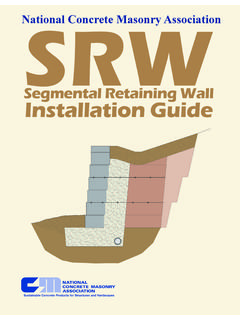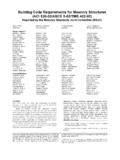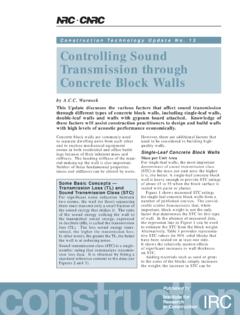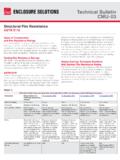Transcription of Concrete Retaining Walls - Retaining Solutions
1 IntroductIonAs the supply of level building sites diminishes, the need to create level building platforms for house construction on sloping sites will increase. Also, on many developed sites there is often a need to level the front and/or back yards to fully utilise the space for carports, gardens, play and entertainment is a common method of achieving level areas but if a batter is used between the level areas so created, a maximum usable area of level ground will not be achieved. Furthermore, on some sites suitable fill may have to be imported and on others spoil disposed of, both of which will add to the cost. The alternative is to use Retaining from Retaining the soil, Retaining Walls can also help protect against erosion on susceptible sites.
2 The requirements of a functional Retaining wall include: structural stability, durability against the exposed environment, and provision of drainage. Appearance will also usually be Retaining Walls provide a durable solution that is required of a structure in contact with soil and exposed to constant wetting and drying. Concrete does not rot and is resistant to termites. The wide range of available options ensures that a suitable solution can be found for any consIderatIonsThe first step in any Retaining -wall project is to check with the local authority to see if planning approval is required. This varies between authorities and is usually related to wall height and drainage provisions.
3 Authorities may require drawings showing a site plan and structural details accompanied by a consultant s design certification. Except for minor low-rise garden Walls , up to, say, 600 mm high, engineering advice should be sought on the wall design for the given is an important aspect of any Retaining -wall project. Water must not be allowed to build up behind the wall. Retaining Walls are designed to resist earth pressures exerted by only the weight of soil retained. These are much less than the hydrostatic pressure exerted by water trapped behind the following parameters influence the design of the Retaining wall:n Wall heightn Soil typen Sloping land below and/or above the Retaining walln Loads above and behind the Retaining wall, eg parked >> Concrete Retaining WallsConCRETE RETA ining Walls provide a durable solution that is required of a structure in contact with soil and exposed to constant wetting and drying.
4 >mAy 2008page 2 of 7 > Concrete Retaining WallsGeneral desIGn prIncIplesSoil restrained by a vertical or near-vertical Retaining wall exerts a lateral pressure against the wall. This pressure tends to cause sliding and /or rotation of the wall which must therefore be designed to resist these forces over the intended design life. Apart from structural design, durability and drainage must also be given particular attention. The design should suit the particular building site and should be undertaken by a professionally qualified consultant in accordance with the Australian Standard AS 4678 Earth- Retaining of Retaining WallsRetaining Walls can be grouped into three distinct categories by considering the way in which they resist the lateral pressure exerted by the soil and any Gravity Retaining Walls These Walls use their own weight and any captured soil/fill weight to resist the lateral soil pressure figure Piled Retaining Walls These Walls use the embedded depth of vertical posts and the strength of the posts to resist lateral
5 Soil forces figure cantilever Retaining Walls These Walls cantilever vertically from the Concrete footing and typically resist overturning by the mass of the soil/material on the heel of the footing figure 3. Within these three categories a number of different and innovative Concrete Retaining wall types are available. Some manufacturers offer technical support, in the form of brochures showing engineer- designed details, for their particular wall 1: gravity Retaining wallSurcharge (cars, people, etc)Soil bearing pressureFrictionresisting slidingActive earth pressurescausing overturningand slidingSoilSurchargePassive earthpressureresistingslidingWeight ofwall and soilresistingoverturningfigure 2.
6 Piled Retaining wallSurcharge (cars, people, etc)Passive earth pressures resisting overturningActive earth pressures Typical concreteencasement (optional) causing overturningSoilSurchargepage 3 of 7 > Concrete Retaining WallsretaInInG Wall systemsreinforced Concrete masonry wallsReinforced and core-filled hollow Concrete blocks are laid on a reinforced Concrete footing to form a cantilever Retaining wall figure 4. This is an extremely popular system offering benefits that include zero lot lines, a vertical wall face and a range of possible finishes. They are economical to around 3 m in height. Full details of masonry wall construction are provided in Reinforced Concrete masonry Cantilever Retaining Walls Design and Construction guide ( mA51) available from the Concrete masonry Association of Concrete wallsCantilever Retaining Walls can be constructed entirely from reinforced Concrete .
7 The wall can be either cast insitu figure 6, or precast figure 7. The exposed vertical face can be treated in many ways, including the use of textured form liners to give particular patterns or motifs figure segmental Concrete masonry wallsLow-height Retaining Walls (generally m and less) can be constructed from dry stacking specially-manufactured interlocking segmental Concrete masonry units. The Walls behave as a gravity wall. The face of the wall may be vertical, stepped or sloped depending on the units used. The figure 3: Cantilever Retaining wallSurcharge (cars, people, etc)Soil bearing pressureFriction resisting slidingActive earth pressurescausing overturningand slidingPassive earthpressureresistingslidingWeight of wall,footing and soilresistingoverturningSoilSurchargefig ure 4.
8 Reinforced Concrete masonry cantilever Retaining wallVariesOptional capping190 Footing reinforcementextending into wallReinforced and groutedCatch drain where surface with compactedclay or similar (protectfrom erosion)blockwork coresGravel drainage materialand agricultural pipeswith falls to outlet290 Slopingbackfillorsurcharge2200to3400page 4 of 7 > Concrete Retaining Wallsfigure 5: Examples of reinforced Concrete masonry cantilever Retaining wallsfigure 8: Examples of formliners used to create decorative off-form finishesfigure 6: insitu Concrete Retaining wall with decorative off-form finishfigure 7: Precast Concrete Retaining wallpage 5 of 7 > Concrete Retaining Wallsunits are available in a variety of colour and face finishes figure 10.
9 They are extremely popular for Diy installations as they are easy to erect. Full details for this system are provided in Segmental Concrete gravity Retaining Walls ( mA53) available from the Concrete masonry Association of Australia. Local Concrete masonry suppliers should be contacted for specific system segmental Concrete masonry with soil reinforcement wallsWalls of similar appearance to dry-stacked segmental Concrete masonry Walls but without the height limitation can be constructed by connecting the masonry units to layers of horizontal geo-synthetic soil reinforcement placed in the backfill behind the wall units figure 11.
10 As with all Concrete masonry walling units, a variety of shapes, texture and colours are available figure 12. These Walls are a gravity system. However, unlike the earlier segmental Walls , they utilise the soil mass behind the wall to help resist the lateral soil forces. This is usually referred to as reinforced soil technology . it is an engineered system and should be installed under engineering supervision by a competent contractor. Full details for this system are provided in Segmental Concrete Reinforced Soil Retaining Walls Design and Construction guide (mA52) available from the Concrete masonry Association of Concrete masonry suppliers should be contacted for specific system 9: Cross section of typical segmental Concrete masonry gravity Retaining wallfigure 11.







